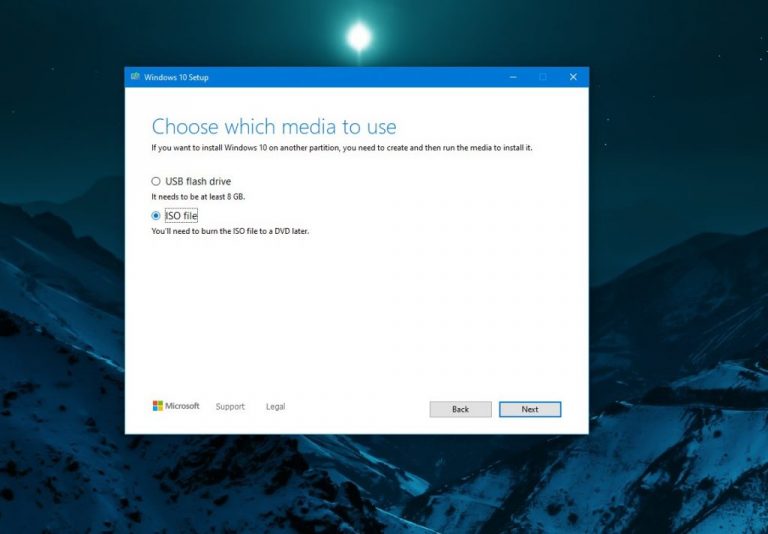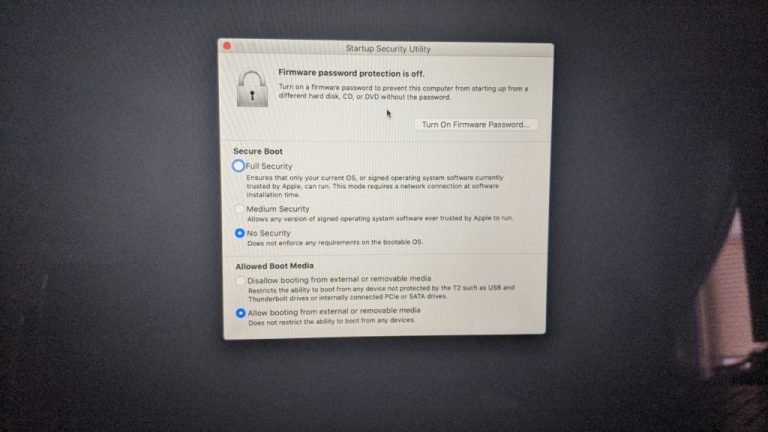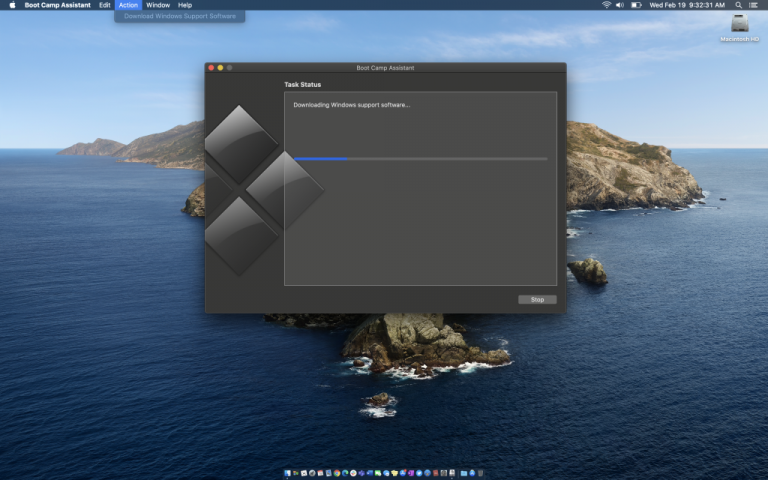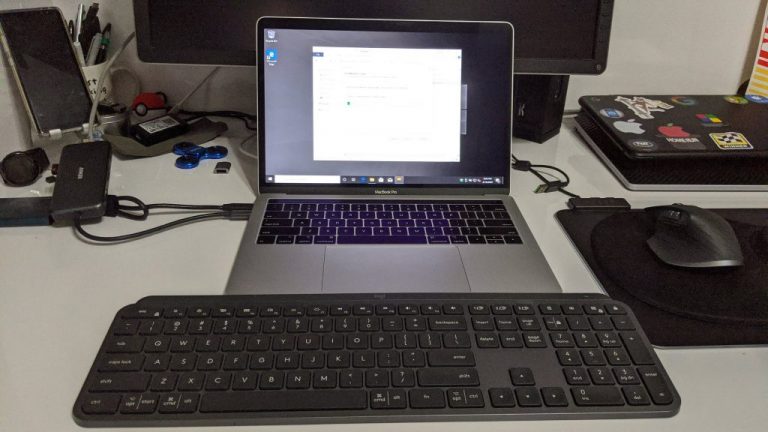How to Download Windows 10 on Mac Without Bootcamp Updated
How to Download Windows 10 on Mac Without Bootcamp
Bootcamp has long been the default mode to run Windows on a Mac. Nosotros've covered information technology earlier, and you can use the MacOS tool to partitioning your Mac'due south hard drive to install Windows in its own space. There are also tools like Parallels, which lets you install Windows in a virtual machine on top of MacOS.
All the same, I recently purchased a new MacBook Pro 2019, and I wondered if it would exist possible to install Windows 10 on information technology, without using Bootcamp. I wanted to specifically do this to proceed my MacOS and Windows stuff separate, and also preserve all of the 128GB of disk space on my base model MacBook for MacOS.
Afterwards doing some enquiry from multiple YouTube videos and guides on Google, I found out how. Please be enlightened, though, that my slice isn't meant to be a guide, it's a personal expect at how I got Windows running on my MacBook, without using Bootcamp. Apple nevertheless recommends Bootcamp equally the all-time method for installing Windows ten on a Mac.
And, just like with using Bootcamp or Parallels on MacOS, I want to mention that I still needed to purchase a valid, unused Windows 10 license primal to legally and properly activate Windows. Finally, I desire to mention that while my method works, you'll be following at your own risk if you decide to use my experience for inspiration. Nosotros can't be held liable for damages to your computer.
Stride 1: Assemble the materials
Before getting started, there were a couple of things I needed. First off, I purchased an external SSD which I knew would be fast enough to handle Windows. I as well had another USB drive handy so I could transfer the Bootcamp support files off my Mac and into Windows during install.
I also needed an external keyboard and mouse. In one case the MacBook initially boots into Windows, the mouse and keyboard the MacBook don't work for the out of the box gear up due to the lack of drivers. Of form, I as well needed to have an existing Windows 10 PC with an cyberspace connexion and a valid Windows 10 install. This is because I had to download a Windows ISO and the Bootcamp support tools, as well as the WintoUSB support tool.
Step 2: Download the Windows x ISO and WintoUSB

To begin my procedure, I headed to my Windows 10 PC and downloaded the Windows 10 ISO using the media creation tool. The download is gratuitous, simply a Windows 10 license is required to activate Windows in one case it successfully booted on my MacBook.
While Windows 10 was downloading, I also downloaded WintoUSB. This is a gratis tool that lets me install Windows 10 to an external SSD drive. The software bypasses the mensurate from Microsoft which disallows installing Windows 10 on external drives. The gratuitous version but allows for the installation of Windows 10 Habitation, but a $25 upgrade volition let you install Windows 10 Pro if wanted.
Step three: Disable the security features of the Apple T2 Chip in the MacBook

Next, I had to turn on my MacBook and disable the security features of the Apple T2 chip. It's a bit like the features built into the BIOS of modern Windows PCs, every bit the Apple T2 scrap is prepare so that a MacBook will merely boot trusted operating systems from Apple.
By default, the T2 Chip also disables the ability to kick from an external drive, and then I had to plough this off this to boot Windows externally. Disabling this had no side effect on my MacOS installation. TouchID and other areas of MacOS still piece of work just fine.
To disable the security features in the T2 bit, I turned on my MacBook. One time on, I held downwards the Command and R keys until I saw the Apple Logo. The MacBook so booted into a recovery space. I and then cull Utilitiedue south > Startup Security Utility from the menu bar.
After authentication, under Secure Kick, I so clicked No Security. And, under external boot, I choose to allow booting from external media. When done, I clicked the X to shut the window. I ended past going to the Apple carte and shutting downward my Mac every bit usual
Step 4: Download the Bootcamp Support drivers

Next up, I had to get back to my MacBook. I logged in as usual and searched for Bootcamp in Spotlight. When it was open, I clicked the menu bar at the top and cull Action, followed pastDownload Windows Support Software. To continue, I saved information technology to my desktop. When finished, I plugged a carve up USB drive into my MacBook and copied the folder and files I simply downloaded.
Footstep 5: Use WintoUSB & so re-create the Bootcamp Files to the Drive

Next, back to my Windows ten PC, I installed WintoUSB and then plugged in the SSD. To get started with this process, I had to click where it says Prototype File. I then navigated to where I saved the Windows ten ISO file, and cull it.
I then had to click Windows x Home and chooseNext. After that, I clicked Next and chose my SSD from the drop-down card. I also had called GPT for UEFI where it says Selected device needs to be formatted. To continue, I choose Legacy under Installation mode and click Next. Win to USB then created a bootable version of Windows. Information technology took about 10-15 minutes to complete.
When the process was finished, I copied the BootCamp Back up files I had downloaded earlier off the USB and onto the root of the SSD with the new Windows install. This was of import for the side by side footstep.
Step half-dozen: Kicking your Macbook from the newly created SSD or USB and and so install the drivers

To end the procedure, I had to boot my MacBook from the external SSD. With the security features of the T2 chip disabled, I did this by holding down the Option Cardinal when I saw the Apple logo. I then cull the external SSD every bit the boot drive. It was labeled UEFI.
Equally Windows didn't have the drivers for my MacBook yet, I had to plug in a keyboard and mouse into my MacBook via 1 of the USB-C ports. I also used a USB-C hub and plugged my Macbook into an ethernet cable, because I wanted to sign in with a Microsoft business relationship on the setup.
I ready Windows equally usual, and one time I was on the desktop, I opened up the File Explorer, and clicked the C drive and opened the folder that says Windows Support.I then launched the Bootcamp set up program to install all the proper drivers for my MacBook.
This terminal function took a while and acquired the Bootcamp installer to freeze, but I used Chore Manager to kill the Bootcamp process and and then rebooted the MacBook and tried again. It eventually worked and I got a working version of Windows running externally on my MacBook!
Why did I practise this? And what are the benefits?
So, the question remains, why did I practice this to begin with? Well, equally I said before, my MacBook Pro only has 128GB of storage. I am using my MacBook for video editing, and then storage is at a premium. I didn't want to run Windows in Bootcamp or in Parallels and accept away valuable storage space from my MacBook. By running it externally from an SSD, I freed upward that space, and I was able to keep Windows dissever from MacOS. This is 1 advantage to my method.
I besides opted for a 500GB SSD, so I was able to gain more than storage infinite that my MacBook has for Windows to begin with. And, since I mainly use Windows on a daily basis, I had the aforementioned storage space for Windows that I practice on my usual Windows car, the Surface Laptop 3. I actually am using my MacBook as my primary machine now, too, for this same reason.
Of class, there are some caveats. Windows 10 works fine on a MacBook when running externally. The battery life and overall arrangement operation of the MacBook are the same as it would exist if Windows was running on an internal bulldoze. That's nearly 6 hours of bombardment and proficient performance for multitasking in Edge.
Nevertheless, the read and write speeds in Windows are not nearly as fast as information technology would be if it was running on the MacBook's internal SSD. This is due to the limitation of the external SSD itself, which only hits around 550MB/S read and write speeds.
However, though, this is a nifty niggling trick that I am glad I pondered upon. Some people might want to effort my method to plow a MacBook into a full-blown Windows motorcar.
Share This Post:
How to Download Windows 10 on Mac Without Bootcamp
Posted by: schmidtsuliterty.blogspot.com
